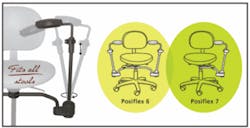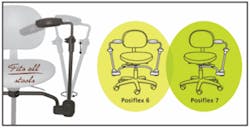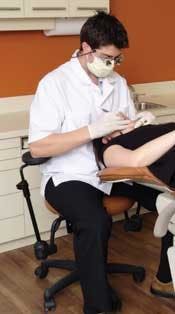Ergonomics and your practice's bottom line
by Cynthia A. Chillock, RDH, EF, AP
For more on this topic, go to www.dentaleconomics.com and search using the following key words: ergonomics, Cynthia Chillock, musculoskeletal disorders.
If you have not recently had to hire a part-time team member to temporarily replace an injured employee, ergonomics may not be something you think about daily. EVIDENCE SUGGESTS THAT PERHAPS YOU SHOULD. By the time you add in the costs of a temporary service to the cost of replacing a regular team member, it may take months for you to recoup those expenses. Additionally, the stress placed on the remaining team members to "pick up the slack" is extremely high during this time. Work-related musculoskeletal disorders (MSDs) can have a significant impact on the bottom line of a dental practice.
There's good news, though. New technology in the form of free-motion elbow supports has been introduced. This gives us another important weapon in the fight against lost work time and revenues due to MSDs. The effectiveness of this technology is backed by the first study in the industry that directly measures the physical stress required to provide dental care. This study conclusively demonstrates that the technology reduces the level of voluntary muscle contraction to safe levels, which assures protection against MSDs.
Installing free-motion elbow supports on existing dental seating for all members of the dental team, or purchasing new seating with free-motion elbow supports, can improve the health and well being of the entire team. When coupled with minor and easy-to-implement changes in work habits and posture, it can dramatically reduce fatigue, improve efficiency, and significantly reduce work time lost to MSDs. This translates to improvement in your practice's bottom line.
Let's look further into what happens when a team member loses work time to a work-related injury. Besides hiring a temporary replacement, another alternative is to cancel patients. For most practices, this is not really a viable option. If the injured employee needs to be permanently replaced, it may take up to 12 months to find the right replacement and successfully merge that new team member into the practice. It could take even longer before patients feel comfortable with the new person. If the injured person is the dentist, the practice might even need to close, leaving the entire team out of work. Bottom line — it's cheaper to prevent injuries.
MSDs are not limited to debilitating injuries. Even in the absence of pain, the fatigue that comes from long days of providing dental therapy can often reduce effectiveness and efficiency. What's more, stress on muscles and joints can lead to more serious conditions over time. It is virtually impossible to be as thorough as you need to be in providing dental care when you're experiencing fatigue and pain, and this can ultimately affect the quality of care.
Even if you exercise regularly and receive chiropractic and other therapies, you may still be at risk for more serious MSDs, not to mention that the costs involved can quickly add up. The additional bodywork required to maintain a dental career can lead to frustration and burnout.
Constant fatigue can leave one with little energy for the family after work hours, which contributes to diminished quality of life. It's not surprising that many professionals spend several thousand dollars on the perfect home recliner to combat the pain and fatigue they experience due to their profession. Unfortunately, that super recliner will not counteract or prevent the reason for their health issues.
Dr. Myron Wentz, founder of USANA Health Sciences in Utah, said, "True health is not necessarily the absence of illness. True health is the capacity of your body to perform in an optimal way."
Because MSDs have become so widespread, addressing them is important to career longevity. Surveys of dental professionals reveal that more than 60% of dentists and hygienists experience often-debilitating muscle and joint pain as a result of their work. A 2002 study done in Quebec Province, Canada reported the average lost work time and revenue resulting from a shoulder injury to a dental hygienist was more than 200 days per year and nearly $25,000.
Another recent study was conducted at the Occupational and Industrial Orthopedic Center in Mount Sinai, New York. This study found that in the dental profession alone, MSDs cost American dental practices billions of dollars annually in compensation costs, lost wages, and productivity. Injuries to the nerves, tendons, muscles, and skeletal structures in the shoulder, back, arm, and wrist were included. And as I've noted, the loss of efficiency due to untreated MSDs results in direct revenue loss to dental practices.
Until recently there had been no studies conclusively demonstrating the effectiveness of specific technologies in preventing MSDs. The first such study was performed in Montreal, Quebec, in 2003 under the auspices of the Association for Safety and Health in the Workplace, Social Affairs Section (ASSTSAS), and its results were convincing. This study used electromyography to directly measure the stress placed on muscles in the neck and upper back by prolonged, static postures required when administering dental treatment.
The study found that even when working in a seated position, dental personnel often held their arms in a position of abduction (up and away from the body) for long periods of time. This caused undue muscle fatigue, which over time resulted in reduction of blood supply to the muscles. This reduction gradually escalated to the degeneration of muscle tissue, nerve compression, and joint and spinal disorders or MSDs. In addition, back injuries due to excess flexion of the neck and improper posture from the seated position are frequent among dental professionals.
The study tested its subjects as they performed therapy in their usual manner. The participants then received brief training using seating with free-motion elbow supports and slight revisions in their seating positions while delivering therapy. When providing the same therapy with the benefit of the new technology, the results were dramatic.
The study measured each participant's maximum voluntary muscle contraction (MVC). It then measured the percentage of MVC used when administering dental care. When performing therapy in their usual manner, the study participants' exerted effort that exceeded 10% of their MVC, a level more than twice the safe amount.
This level put them at high risk for MSDs. When they performed the same therapy using free-motion elbow supports, the results were strikingly different. The participants reduced their MVC to less than 5%, a level that virtually eliminates the risk of MSDs.
The results prompted the designers of the study to make several recommendations to reduce MSDs in dental practices: Among these, they strongly recommend installing free-motion elbow supports as the key technology in reducing and eliminating MSDs from the dental workplace. Supports can be installed on existing dental seating or by purchasing new seating, which incorporates the free-motion elbow supports.
In addition, several recommendations were made for changing work habits:
• Dental personnel should raise the height of the patient's chair relative to their position. This enables the dentist or hygienist to reduce neck flexion to less than 20 degrees. It also enables them to work with their legs under the patient's chair, which reduces the likelihood of awkward positioning caused by the legs straddling the patient's chair.
• A greater percentage of dental therapy should be provided from the 11 o'clock, 12 o'clock, and 1 o'clock positions. Free-motion elbow supports enable this. These positions significantly reduce muscular stress to dental personnel when compared to working from the side or in front of the patient.
One of the things the study participants commented on was that the free-motion elbow supports provide a constant reminder to work in correct positions. They found this to be very helpful in reducing joint and muscle stress as they were providing therapy.
Another important factor is that most dentists work with a chair side assistant and most hygienists do not. Working alone adds additional stress to the muscles and joints of the head, neck, and upper back. While most dentists use their non-dominant hand for retraction, hygienists have the additional challenge of routinely holding suction in their non-dominant hand.
Because of this, it is even more important that the hygienist sit in the more ergonomically comfortable positions of 11 o'clock, 12 o'clock and 1 o'clock, and use elbow support.
When you take important steps to help your practice reduce time and revenue lost to work-related injuries, you are also taking steps to improve your practice's bottom line. Preventable work-related injuries are among the most significant causes of reduced profitability to your practice, and choosing the most effective way to reduce or eliminate them is critical.
The evidence is very convincing that by simply installing the new technology of free-motion elbow supports and making small changes in team members' working habits, dental practices can realize a substantial positive impact to their bottom line. The added benefit is that this improved financial performance is achieved by helping dental team members reduce the likelihood of MSDs and bring comfort and freedom from pain into their daily lives. This is one of the best internal marketing ideas, since happy employees make for happy patients. By making this investment in your health and practice, you will reap even greater financial rewards.
Cynthia A. Chillock, RDH, EF, AP is a consultant, speaker, author, instrumentation and fourhanded clinical care trainer, CEO of Perio-Data™ and lead singer for The Salivary Singers. Her 43 years in dentistry have included office clinical care, office management, public health, and clinical faculty positions. She has been a member of DANB – Infection Control Exam Committee, educational consultant to Sunstar, and past president for ASDHA. She can be reached by phone at (520) 323-5602 or at www.perio-data.com or www.salivarysingers.com.


